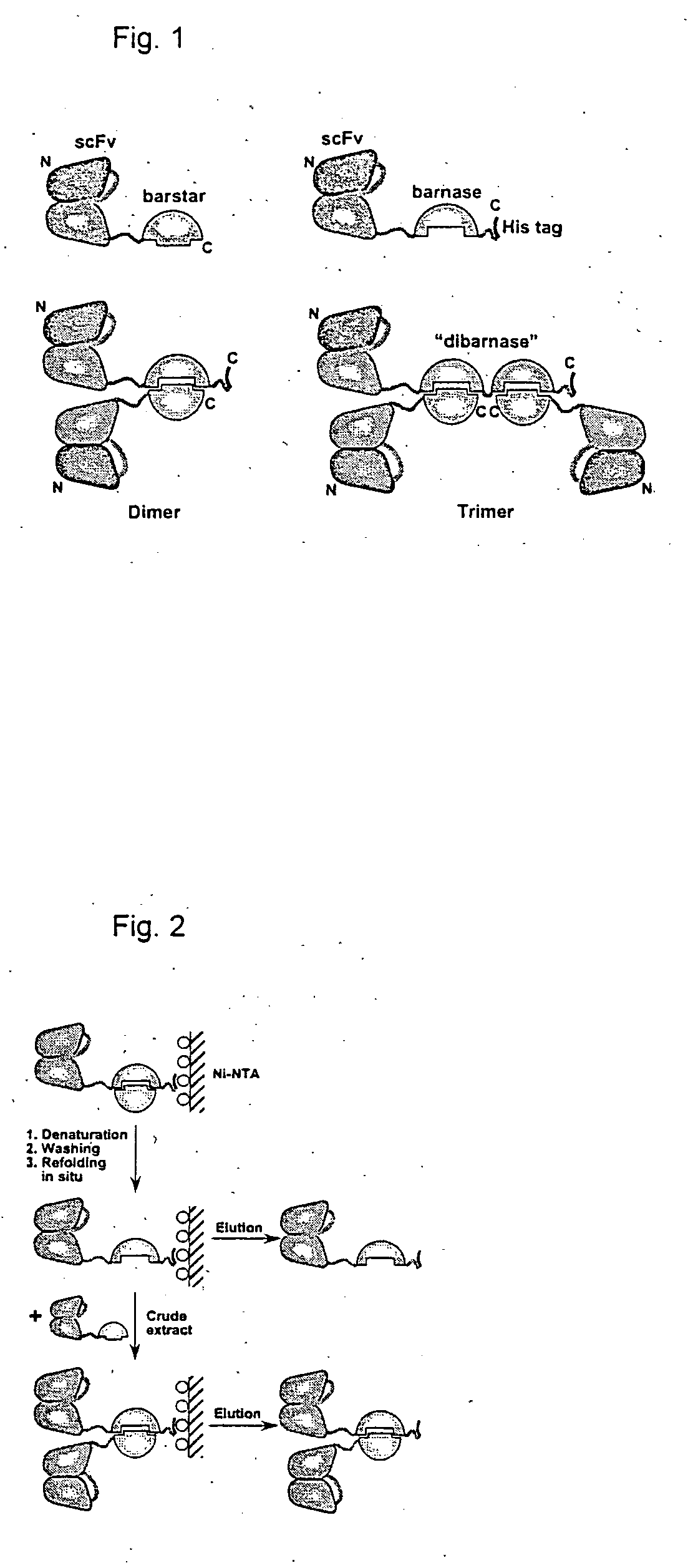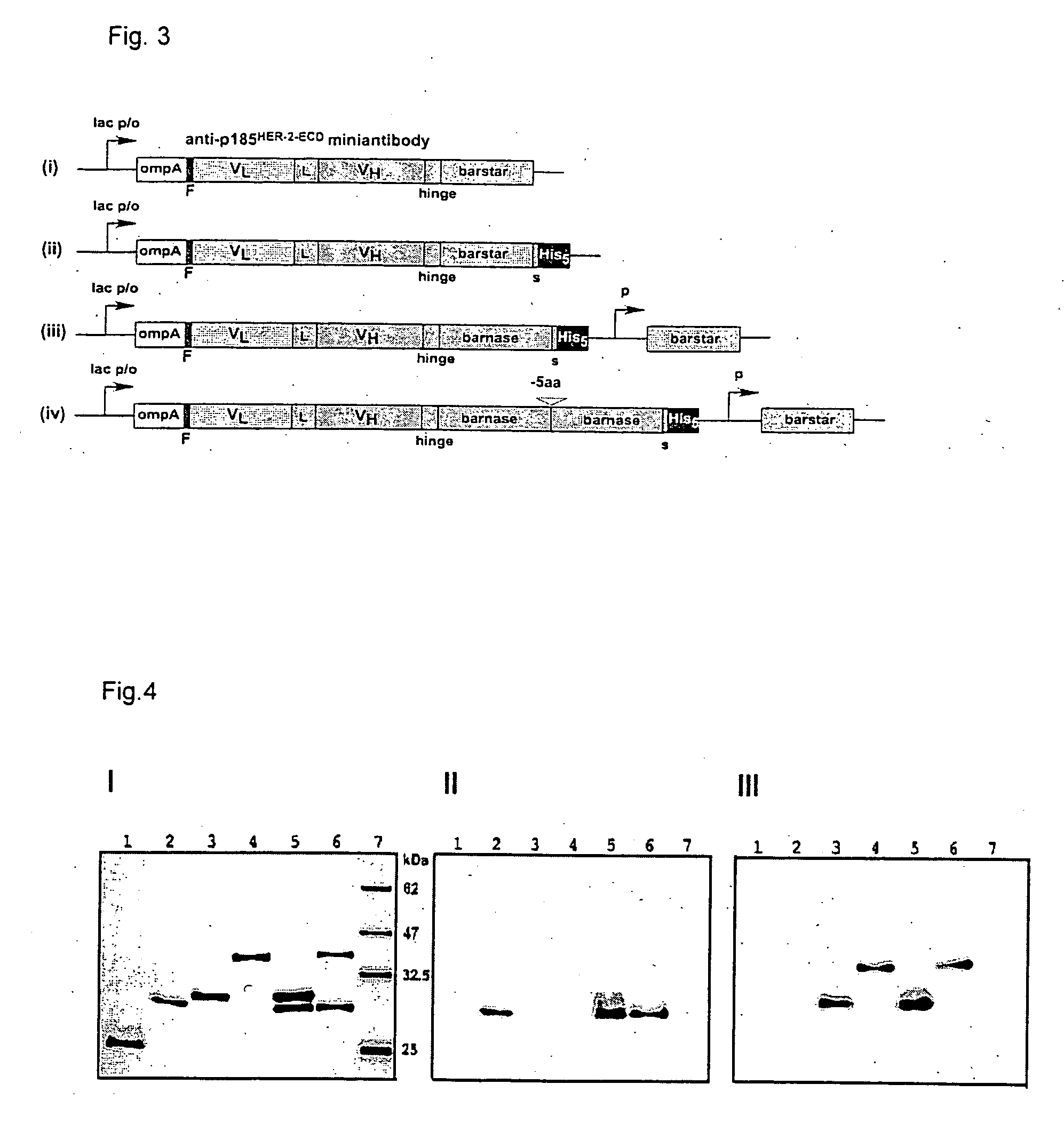Multivalent complexes, their production and method of use
a multi-complex and complex technology, applied in the field of multi-complexes, can solve the problems of high dissociation rate, inability to publish constructs, and high kidney accumulation inherent in the kidneys
- Summary
- Abstract
- Description
- Claims
- Application Information
AI Technical Summary
Benefits of technology
Problems solved by technology
Method used
Image
Examples
example 1
Construction of Expression Plasmids
[0049] The plasmids for the periplasmic expression of scFv-barnase and barstar fusion proteins are based on the vector pIG64D5 (Knappik, A. & Plückthun, A. Protein Eng. 8, 81-89, 1995).
[0050] The barstar and barnase genes were amplified out of the plasmid pMT413 (Hartley, R. W. Biochemistry 32,5978-5984,1993) using the primers Ascl_bs-fwd: 5′-TGGCGCGCCGAAAAAAGCAGTCATTAACGGG-3′, bs_Ascl-rev: 5′-CG GCGCGCCAGAAAGTATGATGGTGATGTC-3′, Ascl_bn-fwd: 5′-GTGGCGCGCCTGCACAGGTTATCAACACGTTTG-3′ and bn_Ascl-rev: 5′-GTGCGGCGCGCCTCTGATTTTTGTAAAGGTCTG-3′. The Ascl fragments were ligated into the vector plG64D5. The plasmid encoded fusion protein: VL-linker-VH-hinge-barstar-His5-tag was easily obtained. In contrast, no clones with the correct barnase gene were found. To obtain 4D5 scFv-barstar derivative without a His-tag, the BspEI / HindIII fragment was cut out from the 4D5 scFv-barstar-His5 encoding plasmid and replaced by BspEI / HindIII part from the plasmid pMT41...
example 2
Molecular Modeling
[0051] The models are based-on the X-ray structures of humanized anti-p185HER2-ECD antibody 4D5 version 8 (PDB entry 1FVC, 2.2 Å resolution)14 and the structure of the barnase:barstar complex (PDB entry 1BGS, 2.6 A resolution)15. The flexible tags, linkers and hinge residues were modeled as beta strands and shaped by simulated melting and annealing using the Discover module of the InsightII molecular modeling suite (MSI / Biosym, San Diego).
example 3
Production of Proteins
[0052] Freshly transformed E. coli K12 strain SB536 (Bass, S. et al., J Bacteriol. 178, 1154-61, 1996) (F−, WG1, ΔfhuA (ton Δ), ΔhhoAB (SacII), shh) cells, grown in SB medium containing 0.1 g / L ampicillin; lac promoter was induced with 1 mM IPTG at an OD550=0.7. Expression was allowed to continue for 16 h at 27° C. Cells were harvested by centrifugation at 6000 rpm for 15 min at 4° C. Cell extracts were prepared by French press lysis at 10,000 psi and centrifugation at 20,000 rpm for 1 h. The supernatants were applied to a Ni2+-NTA column (Qiagen, Germany) according to the manufacturer's instructions. The immobilized proteins were denaturated with 6 M GuHCl in PBS, pH 8.0, refolded using linear gradient 6−0 M GuHCl in the same buffer, washed with 25 mM imidazole and eluted with 200 mM imidazole. For final purification of 4D5 scFv-barnase-His5 and 4D5 scFv-dibarnase-His5 elution fractions were directly applied onto a Protein-A Sepharose column (Pharmacia) and e...
PUM
| Property | Measurement | Unit |
|---|---|---|
| Composition | aaaaa | aaaaa |
| Therapeutic | aaaaa | aaaaa |
| Affinity | aaaaa | aaaaa |
Abstract
Description
Claims
Application Information
 Login to View More
Login to View More - R&D
- Intellectual Property
- Life Sciences
- Materials
- Tech Scout
- Unparalleled Data Quality
- Higher Quality Content
- 60% Fewer Hallucinations
Browse by: Latest US Patents, China's latest patents, Technical Efficacy Thesaurus, Application Domain, Technology Topic, Popular Technical Reports.
© 2025 PatSnap. All rights reserved.Legal|Privacy policy|Modern Slavery Act Transparency Statement|Sitemap|About US| Contact US: help@patsnap.com



